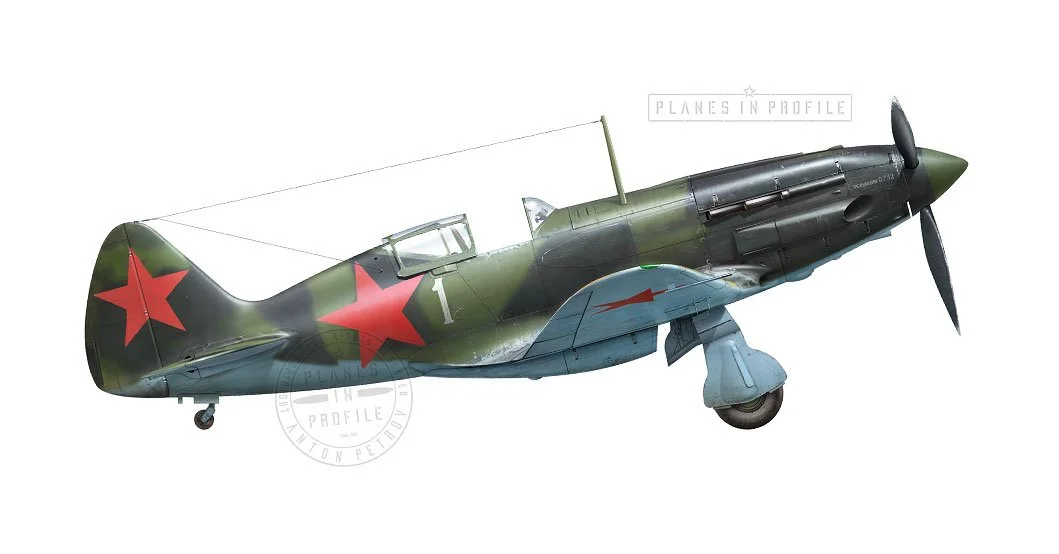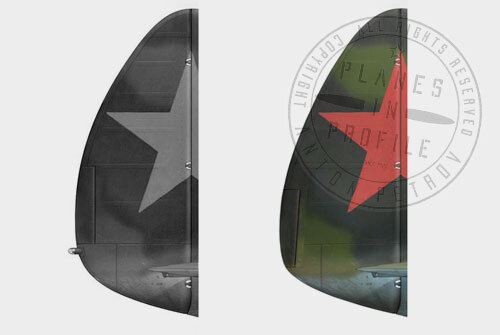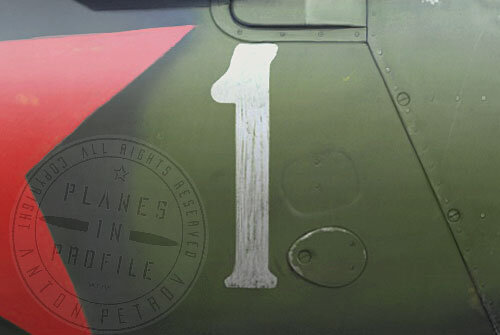WHITE-1
Mikoyan & Gurevich, MiG-3
(Possibly) 8th IAP VMF , Sevastopol, Crimea, Russia. ‘Khersonets’ airfield, spring 1942.
Hardly any information exists about the ‘White-1’ . The closest I got trying to find out about this airplane is perhaps try to determine which regiment it might have belonged to, but even this information proved to be “cloudy”, to say the least. Some sources indicate that ‘White-1’ belonged to 62nd IAP ChF (Massimo Tessitori)[1], others that it belonged to 32nd IAP ChF(ava.org.ru)[2], and yet others that it belonged to the 7th IAP first and then to the 8 IAP, presumably at the time the photo of it was taken. (Mikhail Bykov)[3].
In the latter source Mikhail Bykov writes ( translated from Russian) :
“The first time a small number of fighters of this type (MiG-3) were transferred to the combat units of the 8th IAP was in December 1941, when the remnants of squadrons from the 9th, 32nd and 62nd IAPs of the Black Sea Fleet Air Force were taken in. Then, in January 1942, the MiG-3 squadron from the 7th IAP of the Black Sea Fleet Air Force, which had arrived in Sevastopol, was included in the unit. The regiment did not receive any other MiGs, continuing to maintain the type in service until the evacuation of the regiment from Sevastopol in late June - early July 1942, after which all the surviving MiG-3s were returned back to the 7th IAP” [3]
If this info is correct then it means that MiGs from the 32nd and 62nd IAPs (as per the other two claims) were all at some stage transferred to the 8th IAP VMF. So it is safest to presume that ‘White-1’ might have belonged to the 8th IAP VMF rather than the 32nd IAP VMF or the 62nd IAP ChF.
62 IAP ChF suffered heavy losses from the time it was formed in September 1941. It started with 12 MiG-3 when it was formed and only three months later it was down to 2 MiGs, which it transferred to the 7th IAP [4]. ava.org also claim that 32nd IAP passed on their 5th squadron to the 8th IAP in November 1941, where it became 1st squadron [5].
We also have visual clues to help us get an idea of which regiment the plane belonged to at the time of the photo . This plane looks quite weathered/aged in the high resolution photo, the link to which is below. Because of this it is safer to assume that this photo was taken in 1942 (meaning that it might have been part of the 8th IAP VMF by then, as per Mikhail Bykov’s claim), because in 1941 (While it would have still been part of 62nd IAP, or 32nd IAP, as per the claims of the other two sources) ‘White-1’ would have probably still been a relatively “new-ish” looking plane, in theory, since late type MiG-3s such as ‘White-1’ were manufactured in 1941.
Noteworthy visual characteristics
1. Note the dents at the root of the horizontal stabiliser, as well as the dents on the left side of the fuselage.
2. Note the uncommon shape of the rudder. It seems to be more triangular than usual. The Trimmer seems to be sitting lower and the rear light is missing. This is quite strange and unless the photo reference used for this was photoshopped incorrectly by someone, I am not sure how to explain the slightly deformed tail of this MiG-3. More on this in the Closeup images below.
3. Brush strokes seem to be visible on what must have been a roughly brush painted digit of the tactical number.
4. Seems to be fitted with an inert gas pipe.
5. Looking closely at the photo reference it looks like 'White-1' had a rocket attachment. It's just poking out from under the wing in the reference.
6. Note the unusual rectangle at the base of the wing. Probably a section that's been previously touched up with black paint, or possibly a section of a wing from another MiG.
7. 'Редукция 0732’ (Reduction 0732), specifies the reduction in the engine gear ratio, as can be seen on some 'Late Type' MiG-3s.
8. Retractible tailwheel. The shape of the doors is that of the early type's doors , they have a rectangular cutout in them for the tailwheel.
9. No radio transmitter is visible. 'White-1' was probably only equipped with a receiver.
10. Late type MiG, with slats.
11. Note that the shape of the star on the right side of the fuselage is not perfectly symmetrical. It's probably similar on the left side, though it's hard to be 100% certain based on the poor quality of the reference in the video linked below.
Here are a few closeup images to help illustrate the points above. Full set of closeup images is On Patreon
FOOTNOTES
[1] http://massimotessitori.altervista.org/sovietwarplanes/pages/mig3/white1bis.html
[2] http://ava.org.ru/iap/11gm.htm
[3] https://warspot.ru/1097-samolety-sovetskih-istrebitelnyh-aviapolkov-chast-vii
[4] This info is based on what I found here: https://deruluft.livejournal.com/63854.html
Links To the reference Images and Videos
(‘Links’ rather than actual ‘Photos/Videos’ have been used to avoid Copyright infringements. Please click on the links to be taken to the reference)
A timestamp to a video showing 'White-1' from the left side and from the back:
https://youtu.be/nF2VtPZI77I?t=59
Photos of 'White-1' can be found here:
http://files.balancer.ru/forums/attaches/2017/12/20-5604809-mig-3-gotovitsya-k-vzletu-s-aerodroma-pod-sevastopolem.jpg
And on an amazing website about Soviet War Planes by Massimo Tessitori, here:
http://massimotessitori.altervista.org/sovietwarplanes/pages/mig3/white1bis-fr.jpg
All the work presented on this is page is subject to updates and revisions in the light of new information which might present itself. If you have any new information relevant to this page or disagree with anything that's presented here, then please feel free to contact me through the Planes in Profile Facebook page. Thanks:)





